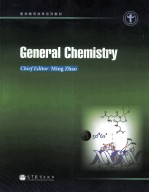
Chapter 1 Introduction 1
1.1 History of Chemistry 2
1.2 Chemistry in Medicine 3
1.3 Measurement of Matter:the SI Unit 7
1.4 Quantitative Ways of Expressing Concentration 10
1.5 Chapter Summary 15
Review Questions 15
Answers 16
References 17
Chapter 2 Colligative Properties of Dilute Solutions 18
2.1 Vapor Pressure Lowering 19
2.2 Boiling Point Elevation and Freezing Point Depression 21
2.3 Osmotic Pressure 24
2.4 Chapter Summary 29
Review Questions 30
Answers 31
References 31
Chapter 3 Electrolyte Solution 32
3.1 Theory of Strong Electrolyte Solution 33
3.2 Proton Theory of Acids and Bases 36
3.3 Calculating the pH of Acid and Base Solution 42
3.4 Chapter Summary 56
Review Questions 57
Answers 58
References 59
Chapter 4 Buffer Solution 60
4.1 Buffer Solution and How a Buffer Works 60
4.2 Calculating the pH ofa Buffer Solution 62
4.3 Buffer Capacity and Buffer Range 64
4.4 Preparing Buffer Solutions 66
4.5 Buffer Solution in Human Blood 68
4.6 Chapter Summary 70
Review Questions 71
Answers 72
References 73
Chapter 5 Equilibria of Sparingly Soluble Ionic Compounds 74
5.1 The Solubility Product Constant,Ksp 74
5.2 The Relationship between Solubility and Ksp 75
5.3 Predicting the Formation of a Precipitate:Q vs.Ksp 77
5.4 Equilibria Shift 77
5.5 Application of Ionic Equilibria to Medicine 82
5.6 Chapter Summary 83
Review Questions 84
Answers 86
References 86
Chapter 6 Colloids and Emulsions 87
6.1 Introduction 87
6.2 Colloid 87
6.3 Sol 88
6.4 Polymer Solution 94
6.5 Chapter Summary 96
Review Questions 96
Answers 97
References 98
Chapter 7 Chemical Thermodynamics 99
7.1 The First Law:The Concepts 100
7.2 The Extent of Chemical Reactions 107
7.3 Indirect Determination of △H:Hess's Law 110
7.4 Energy Values of Food 116
7.5 Chapter Summary 118
Review Questions 119
Answers 120
References 121
Chapter 8 The Direction and Equilibrium of Chemical Reactions 122
8.1 Spontaneity:The Meaning of Spontaneous Change 123
8.2 Entropy and Entropy Change 123
8.3 Free Energy and Free Energy Change 125
8.4 Standard Free Energy Change,△G? 127
8.5 Relationship of △G? to △G for Nonstandard Conditions 128
8.6 Relationship of △G? to the Equilibrium Constant K? 129
8.7 Criteria for Spontaneous Change 129
8.8 Altering Equilibrium Conditions:Le Ch?terlier's Principle 130
8.9 The Le Chátelier's Principle in Physiology 133
8.10 Chapter Summary 133
Review Questions 134
Answers 136
References 137
Chapter 9 Kinetics:Rates and Mechanisms of Chemical Reactions 138
9.1 The Rates of Chemical Reactions 139
9.2 Rate Laws and Reaction Order 141
9.3 Rate Constant and Reaction Order 144
9.4 Reaction Mechanisms:Steps in the Overall Reaction 149
9.5 Theoretical Models for Chemical Kinetics 153
9.6 The Effect of Temperature on Reaction Rates 157
9.7 Catalysis 158
9.8 Chapter Summary 162
Review Questions 163
Chapter 10 Electrochemistry 166
10.1 Oxidation-Reduction Reactions 166
10.2 Voltaic Cell 168
10.3 Electrode Potentials 170
10.4 Free Energy and Electrical Work 174
10.5 Predicting Spontaneous Reactions for Nonstandard Conditions 178
10.6 Chapter Summary 178
Review Questions 179
Answers 181
References 181
Chapter 11 Atomic Structure and Periodical Table 183
11.1 The Discovery of Atomic Structure 184
11.2 Atomic Spectrum and the Bohr Model of the Atom 185
11.3 The Wave-Particle Duality of Matter and Energy 188
11.4 The Atomic Orbital and the Probable Location of the Electron 190
11.5 Quantum Numbers and Electron Orbitals 191
11.6 Electron Configurations 196
11.7 The Periodic Law and the Periodic Table 200
11.8 Chapter Summary 205
Review Questions 206
Answers 208
References 210
Chapter 12 Covalent Bonding and Intermolecular Forces 211
12.1 The Covalent Bonding Model 212
12.2 Hybridization of Atomic Orbitals 220
12.3 Molecular Orbital (MO)Theory 227
12.4 Delocalized Electrons:Bonding in the Benzene Molecule 234
12.5 Intermolecular Forces 235
12.6 Chapter Summary 241
Review Questions 242
Answers 244
References 245
Chapter 13 Chemistry of Coordination Compounds 246
13.1 The Structure of Complexes 247
13.2 Formulas and Names of Coordination Complexes 247
13.3 Isomerism 248
13.4 Chemical Bond Theories of Complexes 249
13.5 Aspects of Complex-Ion Equilibrium 254
13.6 Metals and Chelates in Living Systems 256
13.7 Chapter Summary 257
Review Questions 258
Chapter 14 Acid-Base Titration 260
14.1 Getting Started:Some Terminology 260
14.2 Significant Figures 261
14.3 Acid-Base Indicator 262
14.4 Titration of a Strong Acid with a Strong Base 263
14.5 Titration of a Weak Acid with a Strong Base 264
14.6 Standardization of Acid(Base)Using a Primary Standard 268
14.7 Chapter Summary 269
Review Questions 270
Chapter 15 UV-Vis Absorption Spectroscopy 272
15.1 UV-Vis Spectroscopic Regions 272
15.2 Beer-Lambert Law 272
15.3 UV/Vis Absorbance Bands and Structures 273
Review Questions 275
Notes 276
Index 278
Appendix A—H 283
- 《市政工程基础》杨岚编著 2009
- 《零基础学会素描》王金著 2019
- 《计算机网络与通信基础》谢雨飞,田启川编著 2019
- 《生物质甘油共气化制氢基础研究》赵丽霞 2019
- 《分析化学》陈怀侠主编 2019
- 《花时间 我的第一堂花艺课 插花基础技法篇》(日)花时间编辑部编;陈洁责编;冯莹莹译 2020
- 《Photoshop CC 2018基础教程》温培利,付华编著 2019
- 《看视频零基础学英语口语》宋德伟 2019
- 《化学反应工程》许志美主编 2019
- 《胃癌基础病理》(日)塚本彻哉编者;宫健,刘石译者 2019
- 《全国高等中医药行业“十三五”创新教材 中医药学概论》翟华强 2019
- 《培智学校义务教育实验教科书教师教学用书 生活适应 二年级 上》人民教育出版社,课程教材研究所,特殊教育课程教材研究中心编著 2019
- 《指向核心素养 北京十一学校名师教学设计 英语 七年级 上 配人教版》周志英总主编 2019
- 《习近平总书记教育重要论述讲义》本书编写组 2020
- 《办好人民满意的教育 全国教育满意度调查报告》(中国)中国教育科学研究院 2019
- 《高等数学试题与详解》西安电子科技大学高等数学教学团队 2019
- 《北京生态环境保护》《北京环境保护丛书》编委会编著 2018
- 《教育学考研应试宝典》徐影主编 2019
- 《语文教育教学实践探索》陈德收 2018
- 《家庭音乐素养教育》刘畅 2018
